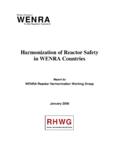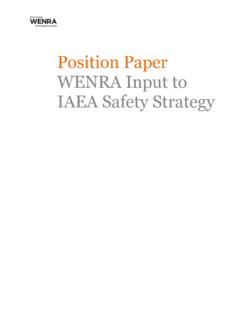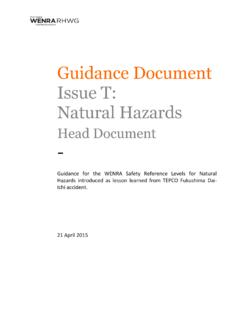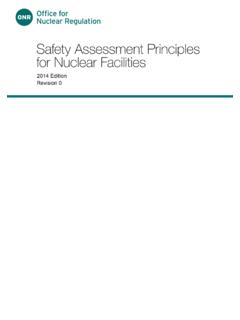Transcription of Report Activities in WENRA countries following the ...
1 Report Activities in WENRA . countries following the Recommenda- tion regarding flaw indications found in belgian reactors - 17 December 2014 Contents Activities in WENRA countries fol- lowing the Recommendation regard- ing flaw indications found in belgian reactors - 01 BACKGROUND 3. The findings in Doel 3 and Tihange 2 3. Metallurgical considerations 3. The role of different inspections 4. 02 THE WENRA RECOMMENDATION 6. 03 FEEDBACK OF THE MEMBER countries 7. General observations 7. Review of answers from the member countries 9.
2 BELGIUM 9. BULGARIA 10. CZECH REPUBLIC 11. FINLAND 12. FRANCE 13. GERMANY 14. HUNGARY 14. NETHERLANDS 15. SLOVAK REPUBLIC 16. SLOVENIA 16. SPAIN 17. SWEDEN 17. SWITZERLAND 18. UNITED KINGDOM 19. Annex Activities with regard to WENRA recommendation plant by plant 20. Flaws in RPV Feedback 17 December 2014 / Page 2 01. Background - The findings in Doel-3 and Tihange-2. In 2012 a new type of in service inspection (ISI) of the reactor pressure vessel (RPV) by ultra . sonic testing (UT) was introduced in belgian nuclear power plants.
3 These inspections were introduced earlier in France to search for underclad cracks that may be present in the base metal directly below the interface to the cladding. These underclad cracks, if present, have perpendicular orientation to the surface and were created by the welding process of the aus . tenitic strip cladding onto the ferritic base metal. Yet, in the RPV wall of Doel 3 and Tihange 2 these inspections did not find any underclad cracks but a large number of flaw indications , located at different distances from the surface in the lower and upper vessel forged rings.
4 As this technique is not suitable to find any flaws far from and nearly parallel to the surface, additional UT with straight beam (0 ) was applied. With this technique, thousands of nearly laminar indications were found at larger depths of the base metal, mostly planar and nearly parallel to the surface of the RPV. following a number of investigations and evaluations, the UT indications in the RPV of Doel 3 and Tihange 2 were unambiguously assigned to hydrogen induced flaws ( hydrogen flakes ). Metallurgical considerations According to current knowledge hydrogen flakes may only form during manufacturing of the base metal.
5 The formation of hydrogen flakes is a phenomenon well known to the steel manufacturers and may happen after cooling down the steel from high to ambient tempera . ture, in the ingot after pouring or in the forged part after the forging operation and heat treatment. Flake formation is driven by the accumulation of hydrogen at segregations or in . clusions in the metal. This accumulation of hydrogen is diffusion controlled, so the formation of flakes may have an incubation time of some days or even a couple of weeks at room tem.
6 Perature. Flaws in RPV Feedback 17 December 2014 / Page 3 Due to the main deformation direction during the forging operation, these segregations or inclusions are preferentially stretched in planes parallel to the surface of the forging leading to the formation of laminar hydrogen flakes of the same orientation. The formation of hydro . gen flakes depends on a number of factors, the most important being the hydrogen concen . tration and the size of the ingot, both determining the possible accumulation of hydrogen. This makes large forgings most prone to flaking.
7 Further important factors are a sensitive microstructure and the stress state. Despite these known dependences it appears difficult to exclude the formation of flakes in a large forging on the basis of these factors. Therefore, acceptance tests of the base material including appropriate UT is considered the most impor . tant step to assure that the parts are free of hydrogen flakes. Therefore the WENRA recom . mendations as well as the WENRA questionnaire specifically asked for the results of these tests. Plate material is generally considered much less prone due to smaller ingot sizes and higher degrees of deformation during the rolling operation compared to forging.
8 This results in a less sensitive microstructure. Therefore, components made from plates are outside the scope of further analyses and are not addressed in the recommendations by WENRA referred to be . low. The flakes are not considered as cracks however they represent a detachment or separa . tion within the material that is assumed to have a similar detrimental effect on the mechani . cal behaviour of the component. In assessments of the structural integrity of the RPV the flakes are always modelled as cracks. The role of different inspections According to international practice, semi finished products, forgings or plates , are subjected to an acceptance tests before they are assembled (mainly welded) to a component.
9 Considering the possible incubation time of the formation of flakes the acceptance tests of forgings are generally not performed before one month after completion of the forging op . eration and the quality heat treatment . According to international practice of the manufac . turers parts showing clear indications of flakes are discarded and will not be assembled. These acceptance tests generally comprise UT with different inclinations of the beam to find flaws of any orientation or character. UT with straight beam (0 ) is the most appropriate to find planar flaws parallel to the RPV surface such as hydrogen flakes.
10 Besides, UT with angle beam, surface testing ( with magnetic particles) and destructive mechanical tests are per . formed. This testing appears to be common practice of all manufacturers, at least since the 70ies. Flaws in RPV Feedback 17 December 2014 / Page 4 In general, more UT is performed after each welding operation, after joining the forgings by circumferential butt welds and after welding of the cladding onto the internal surface of the RPV. These post weld tests aim to check for flaws in the welding, including the interfaces and the heat affected zones in the adjacent base materials.










